As more center console boat owners take up the challenge of fishing offshore for billfish and tuna, the introduction of innovative new gear and boat rigging methods help their cause tremendously. Consistent success trolling for pelagics requires the use of intricate teasers systems. However, trying to match the spread of large sportfishing yachts has been a problem for center consoles - until now. New developments are putting outboard-powered boats on par with the battlewagons.
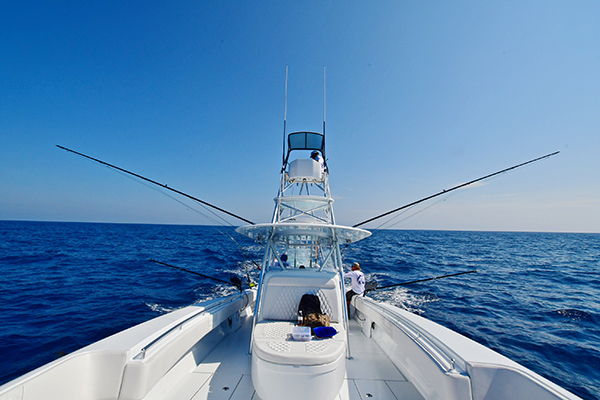
The evolution of the center console boat has been on a steady upward trajectory in both market share and physical size since its introduction more than 50 years ago. The earliest models were diminutive by today’s standard, with most under 20 feet in length. Now center consoles in the 30, 40 and even 50-foot class are becoming commonplace, and they require not just more power, but specialized power. Yamaha has been in the forefront of developing outboards to move these massive hulls quickly and efficiently. Along with more power, Yamaha introduced technological advances in helm controls and electrical power generation that makes their outboards the perfect match for bigger boats while offering fishing features unheard of just a few years ago. The 425-horsepower V8 XTO® Offshore outboard system is the power offered on many of the most popular large center console boats in the market today including Contender One, Contender Boat’s factory tournament boat.
Contender One is a floating development platform that the company enters in a variety of offshore tournaments each year, and it’s a great example of how to set up a large center console for offshore trolling. The boat competes under the watchful eye of Captain Ken Pontari when he is not busy overseeing production at the Contender facility in Homestead, Florida. Pontari has years of experience as a boat builder and a competitor in offshore tournaments up and down the East Coast. He knows what a boat needs to be competitive so when he invited us to join him to see how his boat and team performed under pressure in the Jimmy Johnson Quest for the Ring Series in Atlantic City last summer, we couldn’t resist. Camera and note pad in hand, we met on the dock at 3 AM on the second to last fishing day of the tournament. There was the gleaming white 44-ST, the center of a beehive of activity as trolling baits were rigged, provisions were loaded on board, and tackle checked and rechecked. Pontari was under the boat’s massive t-top conferring with one of the team members and logging waypoints into the chart plotter for the hundred-mile run to the Hudson Canyon area. The three matching white Yamaha XTO Offshore outboards on the transom glittered under the spreader lights shining down from the tower and from the underwater lights glowing up from the transom.
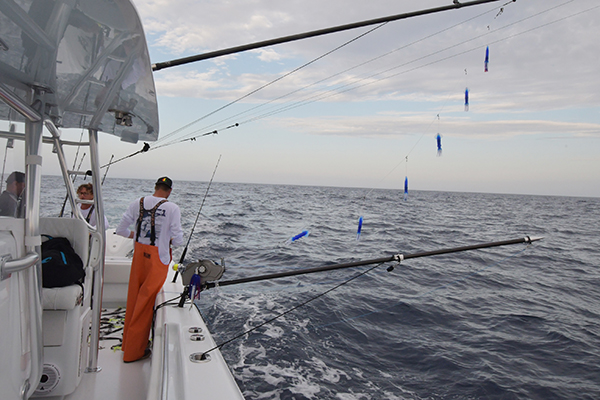
Like so many of Contender’s 44-foot tournament models, this one was purpose-built for chasing billfish and tuna, whether that means fishing sailfish along the Florida coast or making long runs offshore to the canyons found along the edge of the Continental Shelf off the mid-Atlantic states. In addition to the triple XTOs, the boat was equipped with the latest version of the Yamaha Helm Master® EX system including the integrated joystick and autopilot. The system makes running the boat a breeze and trolling incredibly precise from the speed control function to running preprogramed courses with the push of a button on the autopilot.
In the words of Pontari, “I’ve got to give Yamaha a big shout out for the latest electronic control system and its effectiveness while fishing. The single-lever throttle function with speed control makes maintaining engine RPM and trolling speed pinpoint accurate, and the Yamaha autopilot system makes running patterns within areas where we find bait or mark fish a breeze.”
Contender One was sporting a full GAP-style tower to give Pontari an unobstructed view of the water around the boat and the ability to easily see water color changes, weed lines, bait schools or other surface activity from greater distances while keeping a watchful eye on his trolling spread and crew. The second station helm controls on the tower can execute all the Helm Master EX functions. The tower is rigged with 22-foot Gemlux outriggers mounted above the hardtop on the tower legs and festooned with rod holders to keep everything available at a moment’s notice. As the day progressed, we watched as Pontari and team put on a clinic on how to troll effectively for pelagics from a big center console.
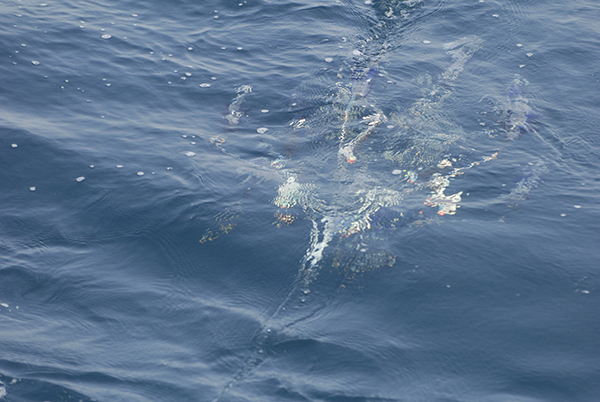
At the beginning of this article, we mentioned teasers are a critical component of a successful trolling pattern for pelagic species, and they fall into two categories—surface and subsurface. This is how Contender One is set up to manage it all.
Surface teasers most frequently consist of a daisy chain of lures or plastic squids which run off the outriggers. These teasers are most effective when the captain can control them from the helm and on Contender One, that means from the tower where Ken spends the day from lines in to lines out. To do that, he had two rod holders welded to the left and right corners of the belly ring of the tower. They hold a pair of short bent-butt rods with electric reels. The heavy monofilament line from the reel runs down through a glass ring attached to the outriggers so when a daisy chain is attached, it’s pulled from a position between the short rigger bait and the flatline bait on each side of the boat. Electric outlets on the tower power the reels. Having the teaser reels within easy reach, the captain can control how far back each daisy chain will run as they splash across the surface creating a commotion.
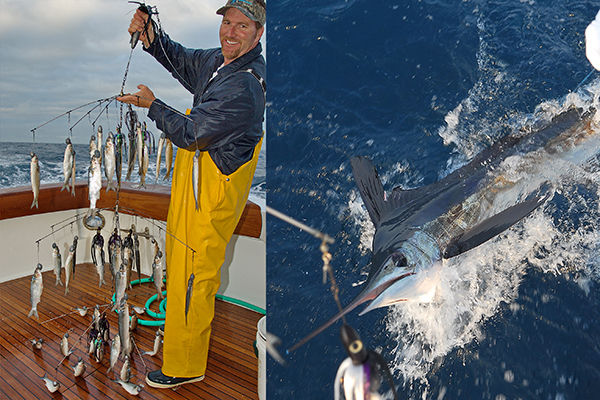
From this position high above the water, he can often see predator fish coming into the spread. When a billfish approaches one of the squid chains, he announces it to the crew telling them where the fish is and which hook baits to move, using the electric reel to move the chain to attract the fish closer or take the chain away so the fish will turn off onto one of the hook baits. Once a fish is hooked, the captain can quickly remove the chains from the water to prevent tangling by engaging the electric reels, which are programmed to bring the chain up to the glass ring and out of the water, before stopping automatically. If the fish is under control on one side of the boat, he can keep the chain on the opposite side in place to attract additional fish to strike or try to position them for one of the crew to drop a pitch bait back trying for multiple hookups. It’s an ingenious arrangement.
The most popular and effective type of subsurface teaser by far is the dredge. They come in a variety of sizes and can be armed with natural baits like splittail mullet or large ballyhoo, a combination of natural baits and plastics, or all plastics. The basic dredge consists of an umbrella-like frame with four or six wire arms that radiate out from a central axis point. Each arm has a chain of multiple baits like mini-squid chains and single baits closer to the center point. Depending on preference, the dredge can be a single, double or triple, which refers to the number of frames rigged one behind the other in tandem. A large triple dredge can contain up to 76 individual hookless baits and is pulled behind a large weight to help keep it down in the water column while trolling. It can weigh upwards of 50 pounds and requires a lot of power to retrieve it.
The whole idea behind the dredge is to create a lifelike, three-dimensional bait ball ripe for the plucking by predators. Its position in the trolling pattern is close to the sides of the boat, anywhere from 20 to 50 feet or more off the transom. Because it’s subsurface, it can be run beneath the rest of the pattern without interfering, but it is usually spaced so it does not block the view of the surface teasers and baits from below. The depth can vary with the amount of weight and the trolling speed but typically for sailfish and marlin, they run ten feet or more down and well behind the boat. Add to that, most boats pull one on each side and you can imagine the impact this presentation has on gamefish, including tuna.
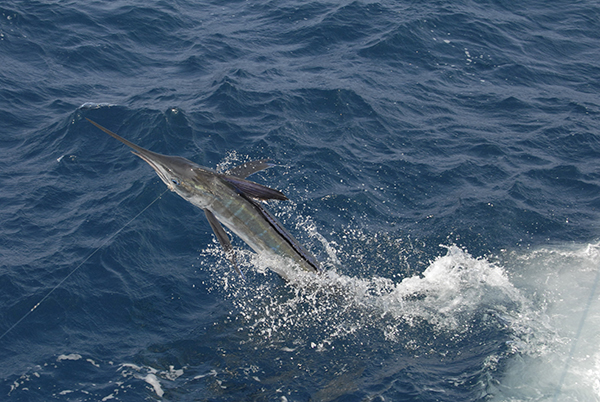
Running a pair of dredges from a center console presented a conundrum and until recently, they were rigged using a few different methods. It wasn’t until the introduction of a product called a dredge boom that heavy dredges came into their own on outboard -powered boats. The dredge boom is actually a system that consists of a heavy-duty aluminum bent rod butt and a pole that can be up to 12 feet long with a pulley on the end. A massive electric reel is mounted on the butt and the dredge line runs through the pulley to a second pulley that creates a block and tackle effect capable of reducing some of the strain on the reel. A safety line runs from the middle of the boom forward to a cleat and tied off to prevent the boom from bending under the strain or from damaging the gunwale rod holder. In position, the boom is pointed perpendicular to the side of the boat, so it holds the dredge out away from the hull, one on each side of the boat. They are positioned aft of amidships, and any position further forward than that increases the possibility of having one of the lines tangled in the propellers. At several hundred dollars a pop, you don’t want to have that happen.
Pontari uses a pair of Gemlux 8-foot Dredge Booms in conjunction with dredges that are a mix of natural splittail mullet and flat rubber fish shaped teasers called mudflaps. Natural dredge baits are preferred for tournament fishing for marlin and sailfish because if a predator sneaks in and grabs one of the baits it gets a real fish, which can keep it coming back into the trolling spread where it can be switched off onto a hook bait. Crew members operate the dredge booms in the cockpit at the captain’s command, while the captain maintains direct control over the daisy chain teasers.
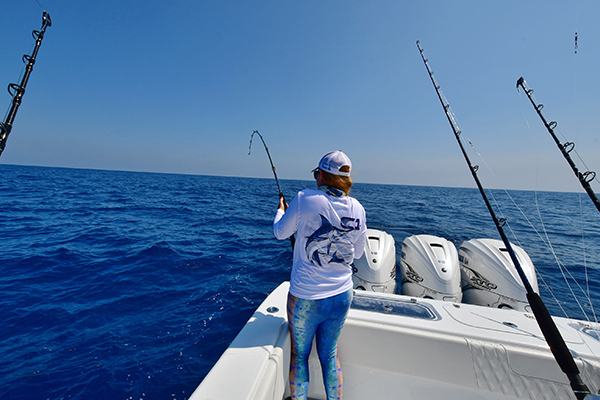
Watching Pontari and crew work their trolling magic during the tournament makes it clear why teasers are such an integral part of a successful offshore presentation. On numerous occasions during the day, Ken worked the boat slowly around schools of baitfish anywhere from the surface to down over 100 feet, drawing interest from white marlin and yellowfin tuna. He even raised a large blue marlin, but it failed to take a hook bait. We listened to him choreograph the action from his perch in the tower shouting out that a marlin was shopping the pattern, approaching it from one side or another, moving toward one of the dredges or daisy chains, and his anglers reacted accordingly by placing rigged ballyhoo baits in position to drop back to the approaching predator. The whole system worked in harmony and produced a number of white marlin and tuna hookups as we photographed the action. There was no doubt Contender One was set up to do anything the battlewagons were capable of - and do it better than most.
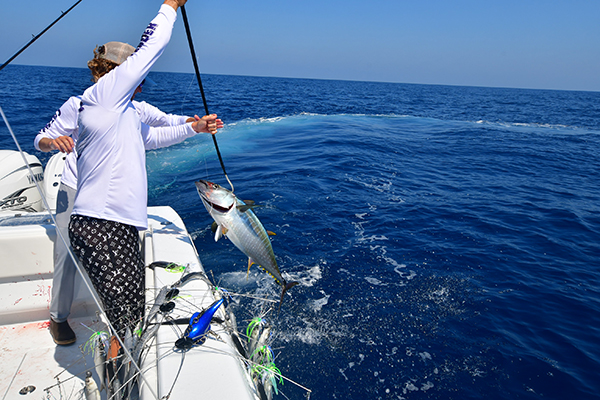
During a follow-up phone call with Ken back at his office in Homestead, we talked more about what we witnessed, and we asked one important question, “Are there any changes you would make to the way the boat was rigged before heading into the next round of tournaments?” “Yes,” he said. “First I plan on switching to 28-foot outriggers. The additional length helps to spread out the pattern and will give me more room for additional baits. That would also place the squid chains a little further apart. And I am going to move the rod holders on the tower belly ring to the outside, so the rods don’t intrude on my view of the spread while remaining easy to reach when I have to.”
Ken also reiterated his affection for the Yamaha Helm Master® EX system and how important it has become to his fishing strategy and execution. Our thanks to Ken and the Contender team for sharing their knowledge and experience. We hope it will help you get your boat in order to challenge offshore pelagics this year.
Back to Blue Life

The evolution of the center console boat has been on a steady upward trajectory in both market share and physical size since its introduction more than 50 years ago. The earliest models were diminutive by today’s standard, with most under 20 feet in length. Now center consoles in the 30, 40 and even 50-foot class are becoming commonplace, and they require not just more power, but specialized power. Yamaha has been in the forefront of developing outboards to move these massive hulls quickly and efficiently. Along with more power, Yamaha introduced technological advances in helm controls and electrical power generation that makes their outboards the perfect match for bigger boats while offering fishing features unheard of just a few years ago. The 425-horsepower V8 XTO® Offshore outboard system is the power offered on many of the most popular large center console boats in the market today including Contender One, Contender Boat’s factory tournament boat.
Contender One is a floating development platform that the company enters in a variety of offshore tournaments each year, and it’s a great example of how to set up a large center console for offshore trolling. The boat competes under the watchful eye of Captain Ken Pontari when he is not busy overseeing production at the Contender facility in Homestead, Florida. Pontari has years of experience as a boat builder and a competitor in offshore tournaments up and down the East Coast. He knows what a boat needs to be competitive so when he invited us to join him to see how his boat and team performed under pressure in the Jimmy Johnson Quest for the Ring Series in Atlantic City last summer, we couldn’t resist. Camera and note pad in hand, we met on the dock at 3 AM on the second to last fishing day of the tournament. There was the gleaming white 44-ST, the center of a beehive of activity as trolling baits were rigged, provisions were loaded on board, and tackle checked and rechecked. Pontari was under the boat’s massive t-top conferring with one of the team members and logging waypoints into the chart plotter for the hundred-mile run to the Hudson Canyon area. The three matching white Yamaha XTO Offshore outboards on the transom glittered under the spreader lights shining down from the tower and from the underwater lights glowing up from the transom.

Like so many of Contender’s 44-foot tournament models, this one was purpose-built for chasing billfish and tuna, whether that means fishing sailfish along the Florida coast or making long runs offshore to the canyons found along the edge of the Continental Shelf off the mid-Atlantic states. In addition to the triple XTOs, the boat was equipped with the latest version of the Yamaha Helm Master® EX system including the integrated joystick and autopilot. The system makes running the boat a breeze and trolling incredibly precise from the speed control function to running preprogramed courses with the push of a button on the autopilot.
In the words of Pontari, “I’ve got to give Yamaha a big shout out for the latest electronic control system and its effectiveness while fishing. The single-lever throttle function with speed control makes maintaining engine RPM and trolling speed pinpoint accurate, and the Yamaha autopilot system makes running patterns within areas where we find bait or mark fish a breeze.”
Contender One was sporting a full GAP-style tower to give Pontari an unobstructed view of the water around the boat and the ability to easily see water color changes, weed lines, bait schools or other surface activity from greater distances while keeping a watchful eye on his trolling spread and crew. The second station helm controls on the tower can execute all the Helm Master EX functions. The tower is rigged with 22-foot Gemlux outriggers mounted above the hardtop on the tower legs and festooned with rod holders to keep everything available at a moment’s notice. As the day progressed, we watched as Pontari and team put on a clinic on how to troll effectively for pelagics from a big center console.

At the beginning of this article, we mentioned teasers are a critical component of a successful trolling pattern for pelagic species, and they fall into two categories—surface and subsurface. This is how Contender One is set up to manage it all.
Surface teasers most frequently consist of a daisy chain of lures or plastic squids which run off the outriggers. These teasers are most effective when the captain can control them from the helm and on Contender One, that means from the tower where Ken spends the day from lines in to lines out. To do that, he had two rod holders welded to the left and right corners of the belly ring of the tower. They hold a pair of short bent-butt rods with electric reels. The heavy monofilament line from the reel runs down through a glass ring attached to the outriggers so when a daisy chain is attached, it’s pulled from a position between the short rigger bait and the flatline bait on each side of the boat. Electric outlets on the tower power the reels. Having the teaser reels within easy reach, the captain can control how far back each daisy chain will run as they splash across the surface creating a commotion.

From this position high above the water, he can often see predator fish coming into the spread. When a billfish approaches one of the squid chains, he announces it to the crew telling them where the fish is and which hook baits to move, using the electric reel to move the chain to attract the fish closer or take the chain away so the fish will turn off onto one of the hook baits. Once a fish is hooked, the captain can quickly remove the chains from the water to prevent tangling by engaging the electric reels, which are programmed to bring the chain up to the glass ring and out of the water, before stopping automatically. If the fish is under control on one side of the boat, he can keep the chain on the opposite side in place to attract additional fish to strike or try to position them for one of the crew to drop a pitch bait back trying for multiple hookups. It’s an ingenious arrangement.
The most popular and effective type of subsurface teaser by far is the dredge. They come in a variety of sizes and can be armed with natural baits like splittail mullet or large ballyhoo, a combination of natural baits and plastics, or all plastics. The basic dredge consists of an umbrella-like frame with four or six wire arms that radiate out from a central axis point. Each arm has a chain of multiple baits like mini-squid chains and single baits closer to the center point. Depending on preference, the dredge can be a single, double or triple, which refers to the number of frames rigged one behind the other in tandem. A large triple dredge can contain up to 76 individual hookless baits and is pulled behind a large weight to help keep it down in the water column while trolling. It can weigh upwards of 50 pounds and requires a lot of power to retrieve it.
The whole idea behind the dredge is to create a lifelike, three-dimensional bait ball ripe for the plucking by predators. Its position in the trolling pattern is close to the sides of the boat, anywhere from 20 to 50 feet or more off the transom. Because it’s subsurface, it can be run beneath the rest of the pattern without interfering, but it is usually spaced so it does not block the view of the surface teasers and baits from below. The depth can vary with the amount of weight and the trolling speed but typically for sailfish and marlin, they run ten feet or more down and well behind the boat. Add to that, most boats pull one on each side and you can imagine the impact this presentation has on gamefish, including tuna.

Running a pair of dredges from a center console presented a conundrum and until recently, they were rigged using a few different methods. It wasn’t until the introduction of a product called a dredge boom that heavy dredges came into their own on outboard -powered boats. The dredge boom is actually a system that consists of a heavy-duty aluminum bent rod butt and a pole that can be up to 12 feet long with a pulley on the end. A massive electric reel is mounted on the butt and the dredge line runs through the pulley to a second pulley that creates a block and tackle effect capable of reducing some of the strain on the reel. A safety line runs from the middle of the boom forward to a cleat and tied off to prevent the boom from bending under the strain or from damaging the gunwale rod holder. In position, the boom is pointed perpendicular to the side of the boat, so it holds the dredge out away from the hull, one on each side of the boat. They are positioned aft of amidships, and any position further forward than that increases the possibility of having one of the lines tangled in the propellers. At several hundred dollars a pop, you don’t want to have that happen.
Pontari uses a pair of Gemlux 8-foot Dredge Booms in conjunction with dredges that are a mix of natural splittail mullet and flat rubber fish shaped teasers called mudflaps. Natural dredge baits are preferred for tournament fishing for marlin and sailfish because if a predator sneaks in and grabs one of the baits it gets a real fish, which can keep it coming back into the trolling spread where it can be switched off onto a hook bait. Crew members operate the dredge booms in the cockpit at the captain’s command, while the captain maintains direct control over the daisy chain teasers.

Watching Pontari and crew work their trolling magic during the tournament makes it clear why teasers are such an integral part of a successful offshore presentation. On numerous occasions during the day, Ken worked the boat slowly around schools of baitfish anywhere from the surface to down over 100 feet, drawing interest from white marlin and yellowfin tuna. He even raised a large blue marlin, but it failed to take a hook bait. We listened to him choreograph the action from his perch in the tower shouting out that a marlin was shopping the pattern, approaching it from one side or another, moving toward one of the dredges or daisy chains, and his anglers reacted accordingly by placing rigged ballyhoo baits in position to drop back to the approaching predator. The whole system worked in harmony and produced a number of white marlin and tuna hookups as we photographed the action. There was no doubt Contender One was set up to do anything the battlewagons were capable of - and do it better than most.

During a follow-up phone call with Ken back at his office in Homestead, we talked more about what we witnessed, and we asked one important question, “Are there any changes you would make to the way the boat was rigged before heading into the next round of tournaments?” “Yes,” he said. “First I plan on switching to 28-foot outriggers. The additional length helps to spread out the pattern and will give me more room for additional baits. That would also place the squid chains a little further apart. And I am going to move the rod holders on the tower belly ring to the outside, so the rods don’t intrude on my view of the spread while remaining easy to reach when I have to.”
Ken also reiterated his affection for the Yamaha Helm Master® EX system and how important it has become to his fishing strategy and execution. Our thanks to Ken and the Contender team for sharing their knowledge and experience. We hope it will help you get your boat in order to challenge offshore pelagics this year.
Back to Blue Life
